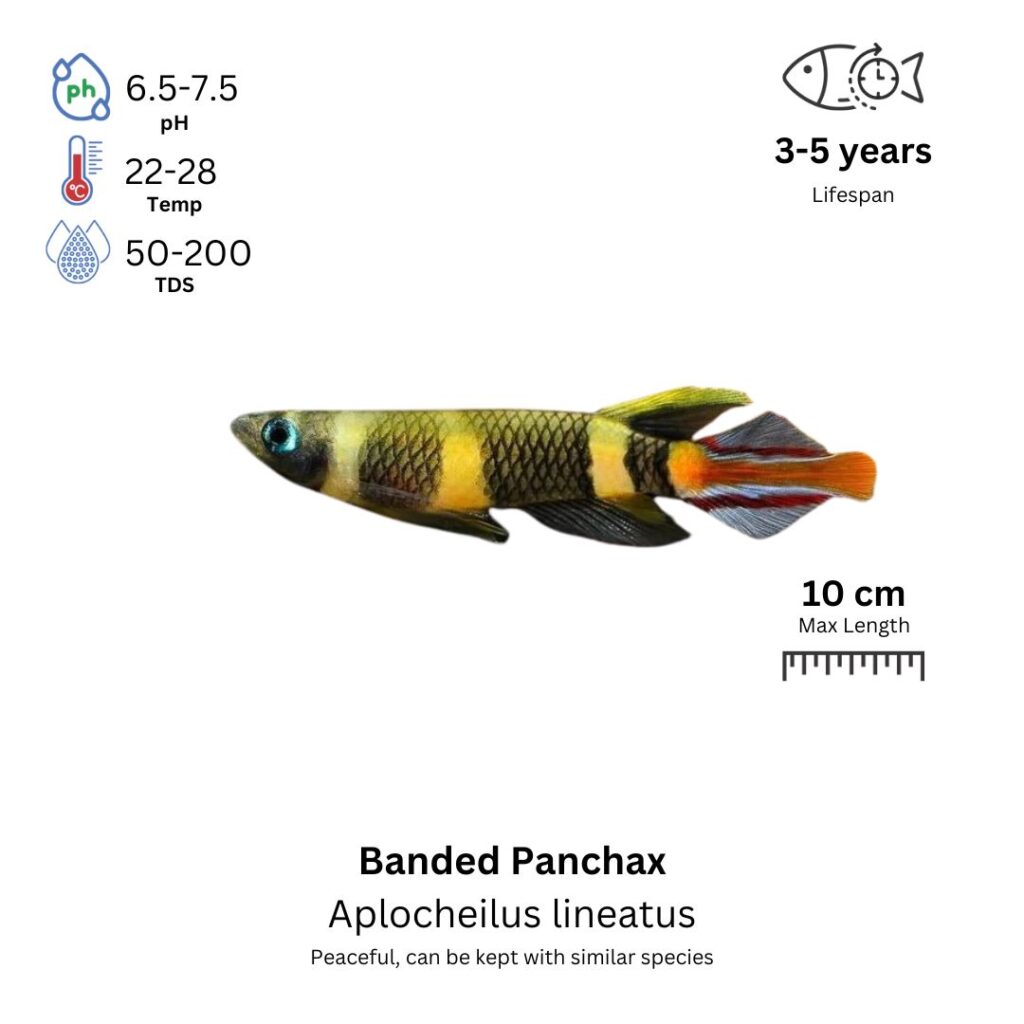Banded Panchax
Aplocheilus lineatus

Description
The Banded Panchax, also known as the Striped Panchax or the Lineatus Killifish, is a small but striking species of killifish known for its vibrant coloration and distinctive pattern. The body of the Banded Panchax is elongated with a silver or yellowish base color, adorned with black horizontal bands running along the length of the body, giving it a “banded” appearance. The fins are generally transparent, with a slight yellow or orange tint. Males are typically more colorful than females, often displaying brighter and more distinct banding. These fish are peaceful, active, and social creatures that enjoy swimming in schools, making them ideal for community tanks. They are lively swimmers and are usually found in the middle to upper regions of the aquarium.
Habitat Origin
Native to South and Southeast Asia, particularly in India, Bangladesh, and Sri Lanka. Banded Panchax can be found in slow-moving freshwater environments, such as ponds, marshes, and streams, where they prefer shallow water with abundant vegetation. They are adaptable fish that can tolerate a variety of water conditions, though they typically thrive in slightly acidic to neutral water with soft to medium hardness.
Aquarium
Ideal Number in Aquarium: At least 6 individuals, as they are schooling fish and feel more secure in groups.
Favorite Food

Banded Panchax are omnivores and will accept a variety of foods. They can be fed high-quality flake food, micro pellets, and live or frozen foods such as brine shrimp, daphnia, and bloodworms. They will also eat small invertebrates, insects, and plant matter in the wild, making them beneficial for keeping algae in check in an aquarium. A varied diet will help maintain their health, coloration, and active behavior.
Behavior:
Banded Panchax are peaceful, active, and social fish that thrive in groups. They are generally calm, but they do become more vibrant and active when kept in schools of at least 6 individuals. These fish are lively swimmers and spend most of their time in the middle to upper regions of the tank. Banded Panchax can be a bit shy at first, especially if kept alone, but once in a group, they will interact more with their tankmates and display their natural, vibrant colors. They are not fin-nippers and do well in peaceful community setups.
Special Care:
Banded Panchax are relatively hardy fish, but they do best in stable environments with soft to slightly acidic water. They enjoy environments with plenty of plants, rocks, and other hiding places. Regular water changes and good filtration are important for maintaining clean water, as they can be sensitive to poor water quality. Since they are not strong jumpers, a secure lid is not absolutely necessary, but it can be helpful in preventing other species from entering the tank. A tank with slow to moderate water flow is ideal, as they are used to calm environments in the wild.
Compatibility with Other Fish:
Yes, Banded Panchax are compatible with other peaceful species, especially those that occupy different levels of the tank. They can be housed with other small, non-aggressive fish like tetras, rasboras, small catfish, and peaceful shrimp. It is best to avoid keeping them with large or aggressive fish, as they may become stressed or intimidated. These fish are perfect for peaceful community aquariums and planted tanks.
Breeding Setup
It is highly recommended to use a separate breeding tank for Banded Panchax to maintain ideal water parameters and prevent egg predation. A 20-liter (5-gallon) aquarium is sufficient for breeding purposes. Maintain a pH of 6.5–7.5, temperature between 24–28°C (75–82°F), and water hardness of 5–12 dGH. Install a gentle sponge filter to keep the water clean without creating strong currents. Include fine substrate and live or floating plants such as Java moss, Anubias, and duckweed to provide cover and egg-laying surfaces. Use moderate, natural lighting to replicate the species’ shaded, shallow-water habitat.
Conditioning for Breeding
Conditioning the Banded Panchax requires a protein-rich, varied diet including live foods (brine shrimp, daphnia, bloodworms), frozen foods, and high-quality flakes. This promotes reproductive health and increases the chance of viable egg production. Regular weekly water changes (25%) are essential to maintain optimal water quality, reduce stress, and encourage breeding behavior. Stable, clean conditions are key to triggering spawning.
Spawning Process
Banded Panchax are egg-scattering fish that usually spawn during early morning or evening hours. Males court females by chasing and showing off their bright colors. A female can lay 50–100 sticky eggs, which will adhere to plants, glass, or other surfaces. Once spawning is complete, it is crucial to remove the adult fish to avoid egg predation, as Banded Panchax are known to eat their own eggs if left in the tank.
Fry Care
Eggs typically hatch in 2–3 days, depending on water temperature. Initially, the fry remain attached to surfaces as they absorb their yolk sacs. When free-swimming, begin feeding infusoria or liquid fry food, and gradually introduce baby brine shrimp or finely crushed flakes as they grow. To ensure healthy development, conduct daily water changes (10–15%), maintain stable temperature (24–28°C), and monitor for ammonia and nitrite buildup, which can be fatal to fry.
Important Notes
Banded Panchax generally reach sexual maturity at 6–8 months. Males are more colorful and smaller, especially when courting, while females are larger and rounder when gravid. To avoid stress, maintain stable water parameters, avoid sudden environmental changes, and house them in a calm tank environment free of aggressive species. Proper conditioning, tank setup, and gentle care are key to successful breeding.
